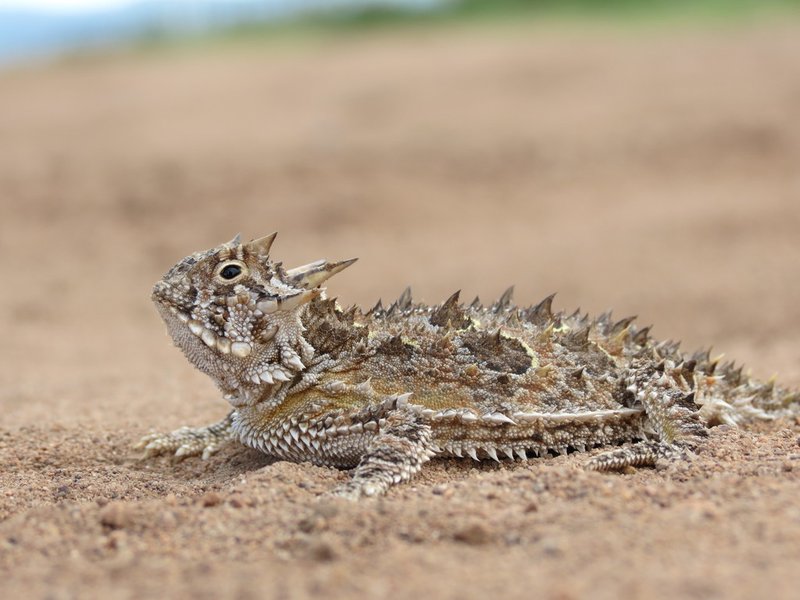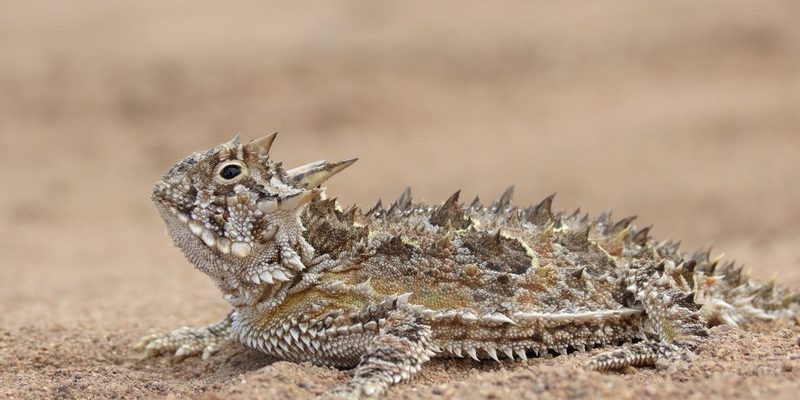
When you think of a lizard, what comes to mind? Maybe a sleek, fast-moving creature darting across the ground. But have you ever met the horned lizard? These unique little guys, also known as “horned toads,” look more like they belong in a fantasy novel, sporting an array of horns and spikes on their backs. They might seem tough, but they’re truly fascinating creatures that adapt in some incredible ways to survive in their harsh environments.
Horned lizards are small, flat reptiles that primarily inhabit arid regions of the United States and Mexico. Their flattened bodies help with camouflage against the sandy ground, and their horns aren’t just for show. These adaptations serve multiple purposes, from deterring predators to regulating their body temperature. You might find yourself wondering how these creatures manage to thrive in such tough conditions, where food and water can be scarce.
Physical Characteristics
Distinctive features define horned lizards. Most notably, their spiked bodies and, as the name suggests, their prominent horns. Depending on the species, these lizards can range in size from around 3 to 5 inches long, with some larger species stretching up to 8 inches. These physical traits are not just for looks; they equip the horned lizard with tools for survival.
Another fascinating aspect of their appearance is their coloration, which varies widely across species and can help them blend into their surroundings. Some are sandy brown or grey, while others may display vibrant colors, which can change with their mood or the environment. This ability to change color is a crucial survival tactic, aiding in both camouflage and thermoregulation.
Habitat and Distribution
Horned lizards are primarily found in the southeastern United States and northern Mexico. They thrive in habitats that range from arid deserts to grasslands. These lizards prefer areas with loose, sandy soil where they can easily bury themselves to escape the heat or hiding from predators. Picture them lounging on a sun-warmed rock, soaking in the rays, or digging into the ground to avoid the midday sun. They’ve got their bases covered when it comes to finding a suitable spot to live.
Their distribution is influenced heavily by the local climate, as they are adapted to cope with extreme temperatures. During the daytime, temperatures can soar, making it crucial for horned lizards to seek shade or burrow into the earth. In contrast, they can tolerate cooler evenings, showcasing their resilience. In fact, they take advantage of the cooler nights to hunt for food without the stress of heat.
Diet and Feeding Habits
You might be surprised to learn that horned lizards are primarily insectivores. Their diet mainly consists of ants, beetles, and various other insects. They utilize their keen sense of sight to spot prey from a distance, and when they do, it’s all about stealth. They often lie in wait for their food to come within striking distance before launching their swift tongue to capture it. This hunting method keeps them energized and ready for their next adventure.
What’s particularly interesting is their feeding behavior. Unlike many reptiles that might feast on larger prey or switch up their diet with fruits and plants, horned lizards stick mainly to insects. This preference means they need to be strategic about when and where to hunt, often feeding in the cooler parts of the day when insects are more active. It makes you think—these little guys have perfected their lifestyle to fit their environment perfectly!
| Size: | 3 to 8 inches in length |
| Habitat: | Deserts, grasslands, and scrublands |
| Diet: | Primarily ants and small insects |
| Coloration: | Ranges from brown to bright colors, adapting to environment |
| Lifespan: | 5 to 10 years in the wild |
| Predators: | Birds, snakes, and mammals |
Defense Mechanisms
In the wild, horned lizards have developed some intriguing ways to protect themselves. Their most notable defense is their ability to flatten their bodies against the ground, making it difficult for predators to spot them. This tactic allows them to blend seamlessly into their surroundings—like a master of disguise! But that’s not all; when threatened, some species can puff themselves up, making them look larger and more intimidating.
Moreover, horned lizards possess a unique ability that can leave you stunned—when cornered, they can actually squirt blood from their eyes! This surprising trick can deter predators, giving the lizard enough time to escape. Imagine the shock of a predator faced with a spurting stream of blood; it’s not your typical defense method, that’s for sure. Certainly, it underlines the importance of survival tactics in the wild!
Reproduction and Lifespan
When it comes to reproduction, horned lizards have a fascinating life cycle. Female horned lizards typically lay between 5 to 30 eggs at a time, depending on the species. These eggs are buried in the sand, where the warm temperatures help incubate them. You can picture a mother lizard carefully finding a special spot in the sand, like a skilled gardener planting her seeds in hopes of nurturing new life.
Once hatched, the young lizards are miniature versions of their parents and can fend for themselves almost immediately. They grow rapidly, typically reaching maturity within a year. In the wild, horned lizards can live between 5 to 10 years, although some individuals may survive longer in captivity. Their lifespan can vary based on environmental factors, food availability, and threats from predators. It’s a rough world out there, but they’ve adapted well over time!
Conservation Status
Despite their unique adaptations, horned lizards face several threats today. Habitat loss due to urban development, agriculture, and climate change are significant concerns, impacting their natural environments. As their living spaces shrink, these lizards find it increasingly difficult to thrive. You might be surprised to know that some species of horned lizards are listed as threatened or endangered! It emphasizes the need for conservation efforts and raising awareness about their plight.
Efforts to protect these quirky reptiles include habitat restoration and the establishment of protected areas. Education plays a crucial role here, too. By informing the public about the importance of horned lizards and their ecosystems, we can contribute to their survival. It’s a community effort, and every little bit counts!
Human Interaction and Myths
Humans have had a long history with horned lizards, often leading to a mix of fascination and misunderstanding. Some people regard them as lucky, while others might believe they possess magical powers. There are even myths claiming that if you touch a horned lizard, it will bring you good fortune. While they may not have any supernatural abilities, the joy they bring to those who appreciate them is undeniable.
Unfortunately, horned lizards can be harmed by human activities. Some are collected as pets, which can disrupt local populations. If you’re considering adopting one, it’s essential to understand their needs and the commitment involved in caring for them. They may look cute and harmless, but they require specific environments and diets to thrive. This is where responsible pet ownership comes into play.
FAQ
What species of horned lizards exist?
There are about 14 recognized species of horned lizards, including the Texas horned lizard (Phrynosoma cornutum) and the greater horned lizard (Phrynosoma platycephalum). Each has distinct characteristics and is adapted to different environments.
How do horned lizards regulate their body temperature?
Horned lizards manage their body temperature by seeking shade during the hottest parts of the day and basking in sunlight when it’s cooler. Their flattened bodies help them absorb heat effectively, allowing them to regulate their temperatures efficiently in extreme conditions.
Can horned lizards change color?
Yes, horned lizards can exhibit color changes to adapt to their environment. This process helps them camouflage from predators and can also be a response to changes in temperature or mood, much like a mood ring for lizards!
Where can I find horned lizards in the wild?
Horned lizards are often found in deserts, grasslands, and scrublands. If you’re on the lookout for these unique creatures, try exploring arid regions of the southwestern United States or Mexico, particularly during the warmer months when they are most active.
How long can horned lizards live in captivity?
In captivity, horned lizards can live longer than they typically would in the wild, sometimes reaching up to 15 years. However, they require appropriate care, including a proper diet, habitat, and conditions that mimic their natural environment.
Do horned lizards make good pets?
While horned lizards can be fascinating pets, they require specialized care that may not be suitable for all pet owners. If you’re thinking about adopting one, ensure you’re prepared to meet their needs and maintain a suitable habitat.
What do horned lizards eat in the wild?
Horned lizards primarily feed on insects, especially ants. Their diet may include various small insects, and they usually hunt during cooler parts of the day when their prey is more active.
Are horned lizards endangered?
Some species of horned lizards are considered threatened or endangered due to habitat loss and other environmental factors. Conservation efforts are ongoing to protect these unique reptiles and their habitats.
How do horned lizards defend themselves against predators?
Horned lizards have several defense mechanisms, including their ability to blend into their surroundings and their unique ability to squirt blood from their eyes when threatened. This surprising tactic can startle predators and provide a chance to escape.
What is the size range of horned lizards?
Horned lizards typically range from about 3 to 8 inches in length, depending on the species. Their unique body structure helps them evade predators and thrive in their environments.
Can horned lizards coexist with other species in their habitat?
Yes, horned lizards can coexist with various other species in their habitats. However, competition for food and space can be a concern, especially in areas where their populations are dwindling due to human impact.
How can I help horned lizards in my area?
You can help horned lizards by supporting local conservation efforts, spreading awareness about their endangered status, and preserving their natural habitats. If you see one in the wild, admire it from a distance and avoid disturbing it.

